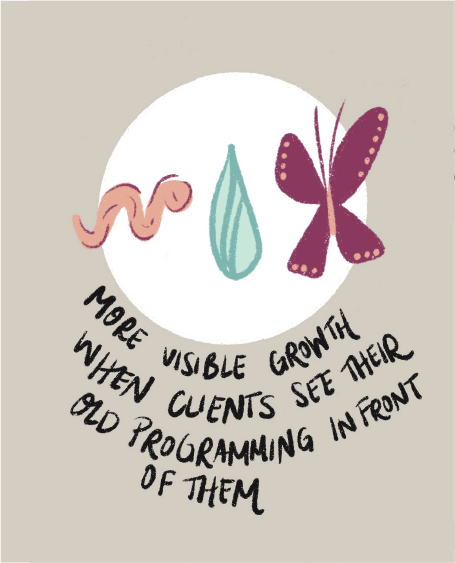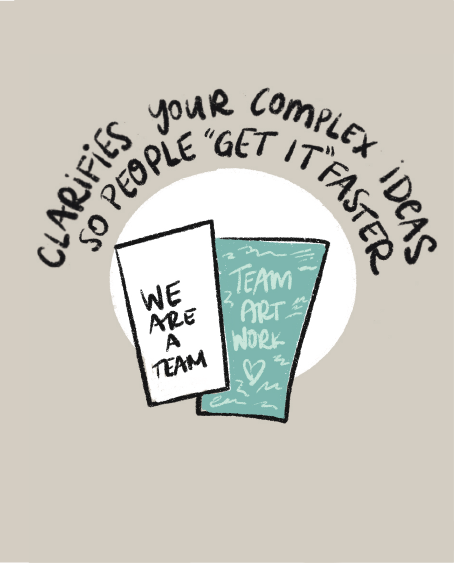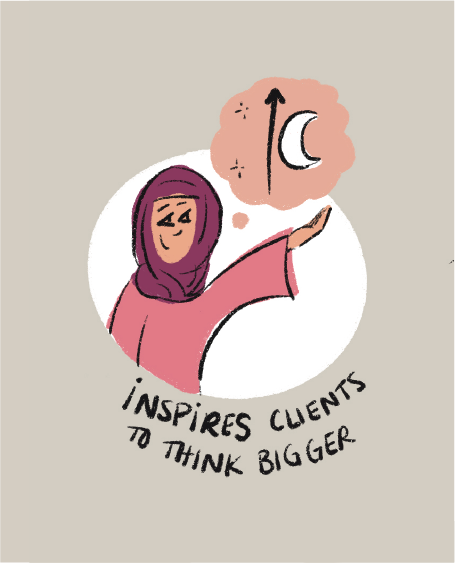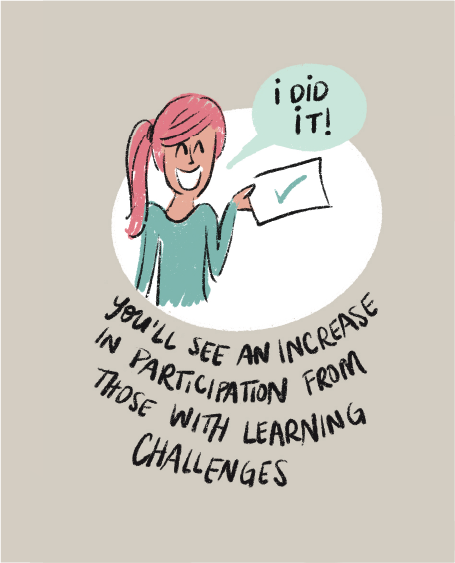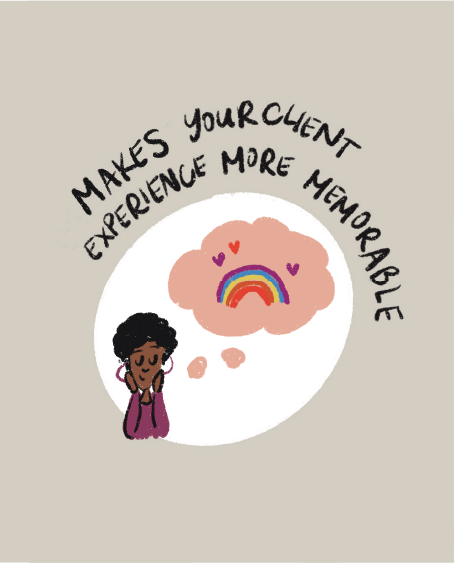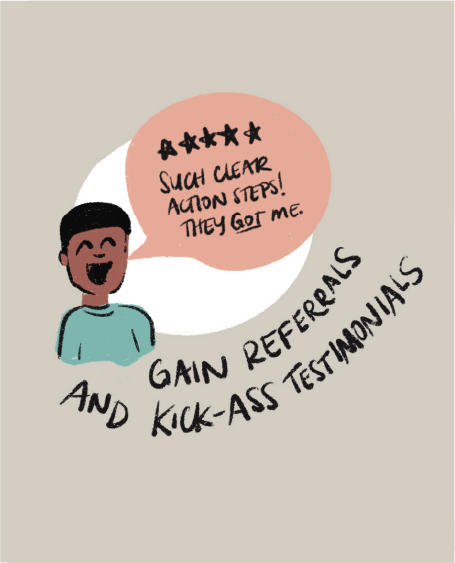Simple Ways To Find Gaps In Your Client Journey, Marketing & Sales
This will take around 9 minutes to read. You can also listen to it instead:
Quick Summary: When you’re deciding which visual aids to use for your clients and community it’s important to step back and look at the big picture. Where are the gaps that could use some support? A gap is a place in your communication or process where people get stuck or start going a different direction than you intended. It’s important to stop, observe and update the environment to support them so they can succeed within your framework.
Everything in this article is based on my lived experience, visual communication training, tons of reading and research and the conversations I’ve had with over 100 clients and as a member in so many group programs and coaching containers. Lived experience is a valuable learning tool so I’m going to share it with you here.
where’s the problem?
It’s easy to tell when things are off in your business but much more challenging to figure out how to actually tend to that gap.
Maybe you notice your students are dropping off a certain point in your course. Maybe your clients keep asking the same question over and over. Or maybe they aren’t taking action. Do you have a product that keeps getting returned?
A client’s interaction with you starts allllll the way back when they first hear of you.
Then they go through the marketing and sales journey/partnership journey /colleague journey
Eventually they walk into the client journey.
They get to know you, work with you, go through edits or extra support and then repeat or move on.
After that comes the post-client journey of repeat projects, sharing about you or partnering.
Taking time to check all of those different journeys to make sure information is clear and that people can connect with you as their authentic selves is important.
big picture Questions to ask yourself
Why are you offering this service/community/product?
What are the most important ideas you want your client to know when they are done working with you?
In what ways are you making sure that this is absolutely clear to them?
The goal as you improve your client experience is to create supportive tools that get a positive reaction. If people are not using it or are still confused, it’s time for an upgrade.
Ways you can make things clearer:
Extra coaching
Visual examples
Real life examples
Walkthroughs
Play and Practice
Thinking in their natural way
Being able to read & understand the work (clear design)
Messaging/Talks/Chats
Guides & Workbooks
Presentations & Audio
Worksheets & Printable Activities
Pictures, Infographics and Charts
Video demonstrations
Transcripts & Notes
Books/Picture Books/Audiobooks
Metaphors & Storytelling
Do you use any of these aids?
Which ones have you gotten positive feedback on? Which ones have people asked for clarification or said they were confused? Which ones have no interacton or feedback from clients?
phrases to look out for:
“I’m not sure what to do next”
When you hear this kind of statement get curious. Are they trying to get you to fix it for them or are they actually not sure what to do next because they’re having trouble reading those cues or holding the timeline in their mind? You can perpetuate the problem if you just tell them that they know the answer and to think about it more. Don’t be afraid to ask them “Where do you feel stuck?” or “Do you want to work through some ideas and see if that helps you get into your flow?” Maybe they need to map it out in a bulleted list or on a timeline. This is an excellent time for visual aids.
“I feel like I should know this by now”
Why don’t they know it? Was it not clear? Do they know what information they are looking for? Take some time to backtrack to find out what they know in this area. Sometimes they have TOO much info and need help simplifying it - perhaps with an activity! Maybe they actually need to do things a different way. Are they trying to make themselves do standard horse things when they are actually a unicorn?
“I have ADHD/Dyslexia/ASD…etc”
Okay, this is very clear and yet so many leaders get scared with these statements instead of asking what support their client wants. If they know their diagnosis then they may also know what they need. If they don’t know how to ask for accommodations then you can go look it up and be a source of authentic support for them. Don’t assume. Ask them if they like to ____ and if ____ would be helpful. For example, “Do you like putting your thoughts on paper? I can give you printable pages to write on after each call?” or “Do you need to walk around to think? Let’s hop off Zoom and chat on the phone while we walk.” “I hear you drumming your hands/see you rocking/notice you pulling your sleeves up, I can give you a moment to think.”
Let’s end the stigma. People with autism are not unpredictable and scary. People with ADHD are not spazzy and hopeless. Someone telling you their brain type is not them trying to “make excuses.” This ends now.
“I don’t know how to do it”
When you hear this don't jump in with “Yes you do” - see what they do know first and work from there. They may have genuinely missed that skill even if it’s “basic.” Everyone has different life experiences and they may have been masking their confusion or their nervous system may have been in fight/flight mode when that lesson happened earlier in their life/career.
“I just need to… try harder / quit it / get focused”
This is a direct repeat of what others have told them in the past. Offer the idea of rest or play. You’ll start again later. When my vision mapping clients come to me like “If I could just get it together” “I just need to plan out my entire life real quick” I give them a game to play before we meet.
“I’m a mess” or “Sorry, I’m all over the place”
Pause… and then get messy!
Validate: “Great! This feels messy! Let’s get messy! Messy is part of creating new things. You must be coming up with something GOOD!!” (need an analogy: legos, birth, moving, crafting, mud pies, baking…)
Take action: “Let’s brain dump into a google doc, let’s play Would You Rather, let’s organize those ideas into piles on a whiteboard real quick.”
The thing is...
A big reason why your client isn’t reaching their goals is probably from limited thinking, not having the information, lack of confidence, etc - all the things guides and coaches look for AND they might not understand what you’re saying.
This is especially true for neurodivergent thinkers. Living life with neurological differences in a world that doesn’t believe you when you ask for help causes all KINDS of limiting beliefs and traumas.
We cannot help someone move through their limiting beliefs and traumas without first believing them.
Sometimes it’s easier to understand how unseen challenges can be supported by thinking of it from the point of view of those with seen challenges. For example, if someone with blindness needs to cross the street it would be irresponsible to give them directions and then tell them to believe in themselves and the directions to get there. They may also need someone to walk with them or a guide dog. That’s not being too needy or dependent. That IS how they show up in the world. With a partner in some cases and on their own in others. Independent success is not the ONLY goal. They trusted YOU as that partner. If you want them to succeed and you’re guiding a part of their journey - you need to be curious and make sure they have what they need to actually make the trek or tell them to trust someone else.
If your clients need visual aids to help them really get the most important concepts you want them to know and to help them remember that concept as they move on through life - shouldn’t it be available to them?
What are some ways you can make your visual support stronger this year? What kind of hestiations are coming up around providing that extra visual support?
Visual Thinking is like a second language - your visual clients are using energy to translate your content - you can meet them halfway.
Side-effects of visual aids
want support with your visual aids? join us for our monthly dig sessions:
Dig sessions are all about digging into your business garden to find the issues that are keeping your beautiful flower clients from thriving.
I’d love to hear which visual aids you are trying out! If you have questions or want to share about your work you can leave a comment below or email me at laura@illustrative.us.
AUTHOR | LAURA MATTESON
Laura is a neurodivergent artist, mother, wife, founder of Illustrative with fancy drawing skills and a huge bucket-full of hope and love for humanity.

